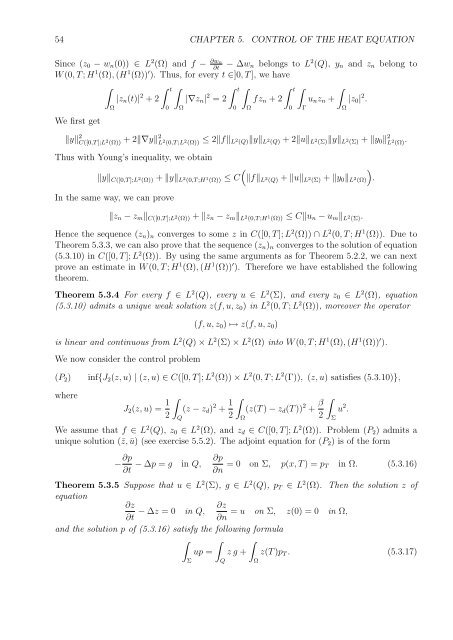Optimal Control of Partial Differential Equations
Optimal Control of Partial Differential Equations
Optimal Control of Partial Differential Equations
Create successful ePaper yourself
Turn your PDF publications into a flip-book with our unique Google optimized e-Paper software.
54 CHAPTER 5. CONTROL OF THE HEAT EQUATION<br />
Since (z0 − wn(0)) ∈ L2 (Ω) and f − ∂wn<br />
∂t − ∆wn belongs to L2 (Q), yn<br />
W (0, T ; H<br />
and zn belong to<br />
1 (Ω), (H1 (Ω)) ′ ). Thus, for every t ∈]0, T ], we have<br />
<br />
<br />
<br />
<br />
We first get<br />
Ω<br />
|zn(t)| 2 + 2<br />
t<br />
0<br />
Ω<br />
|∇zn| 2 = 2<br />
t<br />
0<br />
fzn + 2<br />
Ω<br />
t<br />
0<br />
unzn +<br />
Γ<br />
Ω<br />
|z0| 2 .<br />
y 2<br />
C([0,T ];L2 (Ω)) + 2∇y2L<br />
2 (0,T ;L2 (Ω)) ≤ 2fL2 (Q)yL2 (Q) + 2uL2 (Σ)yL2 (Σ) + y0 2<br />
L2 (Ω) .<br />
Thus with Young’s inequality, we obtain<br />
y C([0,T ];L 2 (Ω)) + y L 2 (0,T ;H 1 (Ω)) ≤ C<br />
In the same way, we can prove<br />
<br />
<br />
fL2 (Q) + uL2 (Σ) + y0L2 (Ω) .<br />
zn − zm C([0,T ];L 2 (Ω)) + zn − zm L 2 (0,T ;H 1 (Ω)) ≤ Cun − um L 2 (Σ).<br />
Hence the sequence (zn)n converges to some z in C([0, T ]; L 2 (Ω)) ∩ L 2 (0, T ; H 1 (Ω)). Due to<br />
Theorem 5.3.3, we can also prove that the sequence (zn)n converges to the solution <strong>of</strong> equation<br />
(5.3.10) in C([0, T ]; L 2 (Ω)). By using the same arguments as for Theorem 5.2.2, we can next<br />
prove an estimate in W (0, T ; H 1 (Ω), (H 1 (Ω)) ′ ). Therefore we have established the following<br />
theorem.<br />
Theorem 5.3.4 For every f ∈ L 2 (Q), every u ∈ L 2 (Σ), and every z0 ∈ L 2 (Ω), equation<br />
(5.3.10) admits a unique weak solution z(f, u, z0) in L 2 (0, T ; L 2 (Ω)), moreover the operator<br />
(f, u, z0) ↦→ z(f, u, z0)<br />
is linear and continuous from L 2 (Q) × L 2 (Σ) × L 2 (Ω) into W (0, T ; H 1 (Ω), (H 1 (Ω)) ′ ).<br />
We now consider the control problem<br />
(P2) inf{J2(z, u) | (z, u) ∈ C([0, T ]; L 2 (Ω)) × L 2 (0, T ; L 2 (Γ)), (z, u) satisfies (5.3.10)},<br />
where<br />
J2(z, u) = 1<br />
<br />
(z − zd)<br />
2 Q<br />
2 + 1<br />
<br />
(z(T ) − zd(T ))<br />
2 Ω<br />
2 + β<br />
<br />
u<br />
2 Σ<br />
2 .<br />
We assume that f ∈ L 2 (Q), z0 ∈ L 2 (Ω), and zd ∈ C([0, T ]; L 2 (Ω)). Problem (P2) admits a<br />
unique solution (¯z, ū) (see exercise 5.5.2). The adjoint equation for (P2) is <strong>of</strong> the form<br />
− ∂p<br />
∂t<br />
− ∆p = g in Q,<br />
∂p<br />
∂n = 0 on Σ, p(x, T ) = pT in Ω. (5.3.16)<br />
Theorem 5.3.5 Suppose that u ∈ L2 (Σ), g ∈ L2 (Q), pT ∈ L2 equation<br />
(Ω). Then the solution z <strong>of</strong><br />
∂z<br />
− ∆z = 0<br />
∂t<br />
in Q,<br />
∂z<br />
= u<br />
∂n<br />
on Σ, z(0) = 0 in Ω,<br />
and the solution p <strong>of</strong> (5.3.16) satisfy the following formula<br />
<br />
up = z g + z(T )pT . (5.3.17)<br />
Σ<br />
Q<br />
Ω

















